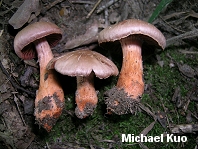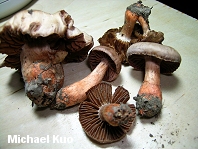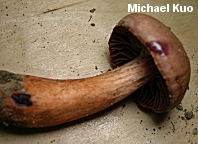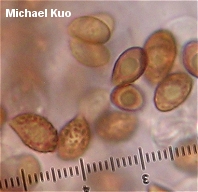| Major Groups > Gilled Mushrooms > Dark-Spored > Cortinarius > Cortinarius rubripes |

|
Cortinarius rubripes [Basidiomycetes > Agaricales > Cortinariaceae > Cortinarius ... ] by Michael Kuo The fiery orange base of this hardwood-loving Cortinarius is quite distinctive, separating it from the hordes of dull, boring members of subgenus Telamonia. Like other Telamonias it is "hygrophanous"--the term in Mycologese for a cap that is moist at first, but soon begins to dry out and change color markedly. When young the cap has purple shades that create an appealing contrast to the orange stem base--but by maturity it becomes more or less dingy cinnamon brown. Cortinarius bulliardii is a similar European species. Below I have cited Kauffman (1906) as the authority for the name Cortinarius rubripes, but Peck's 1906 publication of the same name is a potential competitor. Although my understanding of such things is incomplete, it appears to me that someone in a position of taxonomic authority needs to figure out which 1906 publication was published first. Kauffman (1932) confidently lists Peck's name as a synonym of his own species--although he was less sure in a previous publication (1918) that the mushrooms described by the two authors did indeed represent the same species. Neither MycoBank nor Index Fungorum mentions the Kauffman publication--but this is probably because Peck's publications are incorporated into these databases, while Kauffman's are not entirely incorporated. Description: Ecology: Mycorrhizal with hardwoods, especially oaks; growing alone, scattered, or gregariously; summer and fall; possibly widely distributed in North America (versions of the species, at any rate, are recorded from eastern North America and from California). Cap: 2.5-12 cm; convex, becoming broadly convex, flat, or broadly bell-shaped; moist becoming dry; smooth or silky; purplish cinnamon at first, changing to reddish brown or cinnamon brown as it dries out. Gills: Attached to the stem; fairly well spaced; pale or pale purplish when young, becoming cinnamon to rusty; covered by a cortina when young. Stem: 3-9 cm long; 0.5-2.5 cm thick at the apex; somewhat swollen at the base; dry or moist; smooth or finely silky; pale purplish to brownish, with a fiery orange or bright to brick red base; basal mycelium also brightly colored; sometimes with a rusty ring zone. Flesh: Whitish or dingy brownish. Odor: Fragrant, or not distinctive. Chemical Reactions: KOH gray to purplish on cap surface; instantly dark blue to dark purple on orange surfaces. Spore Print: Rusty brown. Microscopic Features: Spores 7-10 x 4-5.5 µ; ellipsoid, often with one subfusoid end; weakly to moderately roughened; orangish brown in KOH. Cheilo- and pleurocystidia absent. Pileipellis a cutis. REFERENCES: Kauffman, 1906. (Kauffman, 1906; Peck, 1906; Kauffman, 1918; Kauffman, 1932; Smith, Smith & Weber, 1979; Arora, 1986; Kuo & Methven, 2010.) Herb. Kuo 08240205, 08270213, 07230801. This site contains no information about the edibility or toxicity of mushrooms. |
© MushroomExpert.Com |
|
Cite this page as: Kuo, M. (2011, December). Cortinarius rubripes. Retrieved from the MushroomExpert.Com Web site: http://www.mushroomexpert.com/cortinarius_rubripes.html |




